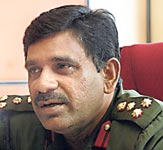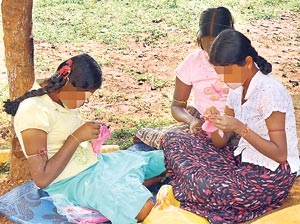They are all smiles…..amidst lessons and extracurricular activity, not only have they seen the sights of Colombo and been fascinated by the animals at the zoo but also had a fast food treat and wandered around the malls peeking into this shop and that. “Yes, I can tie all sorts of knots,” smiles Kumaran* who has taken to Scouting as if it was meant for him and is determined to finish his studies and “get a government job”.
 |
| Brigadier Sudantha Ranasinghe |
Making ready to read a poem on Samadhanam before a large audience of boys and girls, Vasanthi* who will be sitting her Ordinary Level this year is set on becoming a lawyer.
It was not long ago that teenagers like Vasanthi could only take a quick look at their own face, that too very rarely, in a shiny but blurred milk-tin cover and get to “duty”. Now smartly-clad in her white uniform, she has combed her hair into two pigtails and powdered her face before a big mirror.
The future spreads before them full of promise, as they continue their studies at Hindu College, Ratmalana, and gradually leave the past behind, a past they would rather forget after being dragged into a war not of their making, against their wishes. “I drove heavy vehicles,” says Vasanthi while Kumaran who was “taken” to give first-aid was later compelled to get into “active service”.
| Going home
In celebration of the victory anniversary, more will go home on May 18 at a ceremony to be held in Jaffna.
Nearly 500 including 198 children and 72 university students will be re-integrated to society, Brigadier Ranasinghe said. |
“We have given them back their childhood,” says Commissioner-General of Rehabilitation Brigadier Sudantha Ranasinghe who is the “father” present at the party held each month for all the boys and girls whose birthdays fall that month, to see them cut the cake and then himself feed each one a piece.
Rehabilitating and reintegrating the child-victims of the war into society are only part of the silent and concerted efforts that have been on by the Bureau of the Commissioner General of Rehabilitation since the war drew to a close.
As the men, women and children from Mullaitivu, Nandikadal and Jaffna fled the Tiger-stranglehold and we gave them a “big embrace” providing food, clothing, shelter and medicine, with some hiccups at first but smoothly later, an undeniable fact was that some may have had links with the LTTE, explained Brigadier Ranasinghe, pointing out that strong requests to such people to surrender bore fruit with large numbers doing so with others who had been hiding being spotted by June-July 2009.
The final count of those who needed rehabilitation stood at 11,696 which included 594 children (231 girls and 363 boys) and 11,102 adults (2,024 women and 9,078 men). In addition, over 1,300 adults who had been identified as hardcore and taken in during the fighting are to be prosecuted under the legal framework.
The rehabilitation process for the others began full steam by August 2009, after the development of the legal framework, with the children firstly being sent to Ambepussa and 18 PARCs – Protective Accommodation and Rehabilitation Centres being opened up in Vavuniya for the men and women.
The children sent to Ambepussa were given a choice of selecting between formal education or vocational training and those who opted for the first (293 in all) were given the facilities at Hindu College and the balance a home at Poonthottam in Vavuniya, for hands-on courses of their choice such as carpentry, masonry, agricultural programmes in scientific farming, sewing, dancing, IT, in addition to language teaching and also crash courses for those wishing to sit the O/Ls or A/Ls. Drama therapy for children affected by war is another crucial aspect and is to be continued throughout.
“We consider them to be victims and don’t stigmatize them but call them ‘children formerly associated with combatants’,” says Child Rehabilitation Coordinator, Brigadier L.C. Perera who fusses over them like a mother hen and stops journalists asking questions which could re-traumatize them. He not only insists on seeing the photographs of the children but also shows them to the child to assure them that they are not identifiable once published in the newspapers.
Creation of a safe environment and widening their horizons through Guiding, Scouting, cricket, boxing are our aim, he says, adding that when they were brought, all of them wanted to get out of the country. “Today they say they want to go home or they want to become a lawyer or a doctor. That change of mindset gives us immense satisfaction.”
“This is our own, home-grown concept, where those who had links with militants go through rehabilitation and develop into well-rounded people who can then be sent home to get back into society,” stresses Brigadier Ranasinghe, explaining the structures of PARCs.
Each PARC headed by an official Coordinator has 500 people, who are divided into smaller groups of 100 each. Each group of 100 has an official Administrator and Coordinator, with the 100 also sub-divided into four units each with 25 people, who have a team leader selected from among them.
“The team leader is generally a university student from among the 148 who are in PARCs,” he says.
Once the administrative structure was in place, psychological and socio-economic profiles of each and everyone in the PARCs were drawn up for a comprehensive database. Then all aspects needed for a rounded development of the individual, including spiritual and psychological, health, vocational training and livelihood development, computer and language classes were established. Places of worship, meditation and medical centres set up.
The beauty culture course was a hit and when President Mahinda Rajapaksa visited the Wanni on April 1 there were 60 young women who could compete with any models in Colombo to greet him. “It was the first time that most of them had seen themselves in a full-length mirror,” smiles Brigadier Ranasinghe, seeking assistance to train some of the women in pre-school teaching so that they could do so at the PARCs and also in their communities when they go home..
All these people are not here for life, he stresses, explaining that their “level of involvement” is assessed and they are being sent back to their communities. Already, 2,421 including some of whom are sick and old, disabled, pregnant or with infants, are back in their homes. Among them were 396 children.
The wonderful thing about PARCs, according to Brigadier Ranasinghe is that no one has run away from them. The security is to stop any harm coming to them.
“They have seen the light at the end of the tunnel now. They are with the system now, and they have changed,” he adds.
(* Names changed to protect identities)
Peace Villages for families
‘Peace Villages’ for those who are still in the rehabilitation process are being set up so that their families can join them.
Nineteen such families are already living in the first Peace Village established in Jaffna, discloses Brigadier Ranasinghe.
Meanwhile, ‘Family Parks’ are on the cards to enable husbands and wives now separated as they may be in the male and female PARCs to live together and go through rehabilitation together.
There are 159 such couples with 34 babies and 10 single mothers with children, it is learnt.
Another important event being planned for end-May is a mass wedding celebration with all the glamour surrounding such an important occasion.
Unfortunately, most of the couples, who now have several children, had not formalized their marriage while living under the clutches of the LTTE, said Brigadier Ranasinghe.
“They had either just agreed to marry or gone to a kovil. We are getting the consent of the couple, firstly asking the ‘wife’ and then the ‘husband’ and also the parents whether they would like to be married before a Registrar of Marriages and get a marriage certificate,” he explained, adding that the Vavuniya District Secretary has been invited to the function.
There will be cake, he smiles. |



